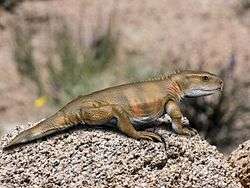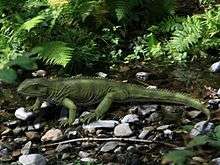Rhynchocephalia
Rhynchocephalia ("beak-heads") is an order of lizard-like reptiles that includes only one living species, the tuatara (Sphenodon punctatus) of New Zealand, which is thought to have two subspecies (Sphenodon punctatus punctatus and Sphenodon punctatus guntheri) the latter was recognised as a separate species from 1989 to 2009.[3][4]
| Rhynchocephalians | |
|---|---|
.jpg) | |
| Fossil of Vadasaurus, a rhynchocephalian from the Late Jurassic of Germany | |
| Scientific classification | |
| Kingdom: | Animalia |
| Phylum: | Chordata |
| Class: | Reptilia |
| Superorder: | Lepidosauria |
| Order: | Rhynchocephalia Günther 1867 |
| Families | |
| |
Despite its current lack of diversity, the Rhynchocephalia at one time included a wide array of genera within multiple (now extinct) families, and represents a lineage stretching at least as far back as the Middle Triassic.[5] Most rhynchocephalians belong to the group Sphenodontia ("wedge-teeth"), which are characterized by a hooked beak-like structure at the tip of the snout formed by enlarged premaxillary teeth.
Many of the niches occupied by lizards today were held by sphenodontians during the Triassic and Jurassic, although lizard diversity began to overtake sphenodontian diversity in the Cretaceous. While the modern tuatara is primarily carnivorous, there were also sphenodontians with omnivorous (Opisthias), herbivorous (Eilenodontinae), and durophagous (Oenosaurus) lifestyles. There were even several successful groups of aquatic sphenodontians, such as pleurosaurs and Ankylosphenodon.[6]
Classification

Sphenodonts, and their sister group Squamata (which includes lizards, snakes and amphisbaenians), belong to the superorder Lepidosauria, the only surviving taxon within Lepidosauromorpha. Squamates and sphenodonts both show caudal autotomy (loss of the tail-tip when threatened), and have transverse cloacal slits.[7] The origin of the sphenodonts probably lies close to the split between the Lepidosauromorpha and the Archosauromorpha. Though they resemble lizards, the similarity is superficial, because the group has several characteristics unique among reptiles. The typical lizard shape is very common for the early amniotes; the oldest known fossil of a reptile, Hylonomus, resembles a modern lizard.[8] R.L. Ditmars, Litt.D, says; "The Tuatara resembles in form stout-bodied modern lizards, which we might call iguanas; this resemblance is further intensified by a row of spines upon the back. It is dark olive, the sides sprinkled with pale dots. The eye has a cat-like pupil. Large specimens are two and a half feet long. While superficial resemblance might tend to group this reptile with lizards, its skeleton and anatomy show it to belong to a different part of a technical classification."[9]
Differences from lizards
A unique feature of the tuatara is a "third eye" on the top of the head. The "eye" has a retina, lens, and nerve endings, but is not used for seeing. It is visible under juvenile tuatara skin but after a few months becomes covered with scales and pigment. The unique eye is sensitive to light and is believed to help the tuatara judge the time of day or season. Additionally, it has two parallel rows of teeth in its upper jaw, and the gap between these rows are where the teeth from the lower jaw fit to perform special grinding/sawing motion to crush prey. Furthermore, the tuatara has a diapsid skull, but lacks a complete lower temporal bar, which separates it from other species as well as its acrodont dentition and overhanging pair of incisor-like teeth. Tooth shape was originally designed for a strictly insectivore diet with piercing teeth. Later on, the teeth became more diversified for various ancestors of the tuatara, which included herbivores, carnivores, and omnivores. The teeth were complex enough to crush crab shells, while others maintained continuous growth in the lower jaw for the breakdown of plant material. Their current dental structure is specialized for grinding up prey after capture. The fossil record shows the tuatara lineage separating from squamates approximately 240 million years ago.[10]


Tuatara were originally classified as lizards in 1831, when the species was discovered by John Edward Gray and the British Museum received a skull. The fossil records show that they have been around since the Middle Triassic, approximately 240 million years ago. The tuatara is traditionally called a "living fossil". This statement has been challenged, as some studies have considered it a model of evolutionary adaptation well adapted to its current conditions, rather than an unchanging remnant of the rest of Sphenodontia.
The genus remained misclassified until 1867, when Albert Günther of the British Museum noted features similar to birds, turtles, and crocodiles. He proposed the order Rhynchocephalia (meaning "beak head") for the tuatara and its fossil relatives. [11] Many disparately related species were subsequently added to the Rhynchocephalia, resulting in what taxonomists call a "wastebasket taxon". These include the superficially similar (both in shape and name) but unrelated rhynchosaurs, which lived in the Triassic.[12] Williston proposed the Sphenodontia to include only tuatara and their closest fossil relatives in 1925.[12] Sphenodon is derived from the Greek for "wedge" (σφήν/sphen) and "tooth" (ὀδούς/odous).[13] However, today Rhynchocephalia is used to include Gephyrosaurus and Sphenodontia, while Sphenodontia excludes the former.[14][15]
Phylogeny
The following is a cladogram of Rhynchocephalia after Rauhut et al., 2012.[16]
| Rhynchocephalia |
| ||||||||||||||||||||||||||||||||||||||||||||||||||||||||||||||||||||||||||||||||||||||||||||||||||||||
References
- Paulo R. Romo de Vivar; Agustín G. Martinelli; Annie Schmaltz Hsiou; Marina Bento Soares (2020). "A new rhynchocephalian from the Late Triassic of southern Brazil enhances eusphenodontian diversity". Journal of Systematic Palaeontology. Online edition. doi:10.1080/14772019.2020.1732488.
- Paulo R. Romo de Vivar; Agustín G. Martinelli; Annie Schmaltz Hsiou; Marina Bento Soares (2020). "A new rhynchocephalian from the Late Triassic of southern Brazil enhances eusphenodontian diversity". Journal of Systematic Palaeontology. Online edition. doi:10.1080/14772019.2020.1732488.
- Ditmars, Raymond L., "Reptiles of the World" The MacMillan Co., New York, 1936, p. xii
- New Zealands department of conservation: https://www.doc.govt.nz/nature/native-animals/reptiles-and-frogs/tuatara/
- Jones, M. E.; Anderson, C.; Hipsley, C. A.; Müller, J.; Evans, S. E.; Schoch, R. R. (2013). "Integration of molecules and new fossils supports a Triassic origin for Lepidosauria (lizards, snakes, and tuatara)". BMC Evolutionary Biology. 13: 208. doi:10.1186/1471-2148-13-208. PMC 4016551. PMID 24063680.
- Reynoso, V. H. (2000). "An unusual aquatic sphenodontian (Reptilia: Diapsida) from the Tlayua Formation (Albian), central Mexico". Journal of Paleontology. 74: 133–148. doi:10.1017/s0022336000031310.
- Cree, Alison. 2002. Tuatara. In: Halliday, Tim and Adler, Kraig (eds.), The new encyclopedia of reptiles and amphibians, Oxford University Press, Oxford, pp. 210–211. ISBN 0-19-852507-9
- "Hylonomus lyelli". Symbols. Province of Nova Scotia. May 2003. Retrieved 24 May 2007.
- Ditmars, 1936, p. xiv
- Tuatara at San Diego Zoo
- Lutz 2005, p. 43.
- Fraser, Nicholas; Sues, Hans-Dieter, eds. (1994). "Phylogeny" In the Shadow of the Dinosaurs: Early Mesozoic Tetrapods. Cambridge University Press. ISBN 0-521-45242-2.
- "Sphenodon". Dictionary.com Unabridged (v 1.1). Random House, Inc. Retrieved 8 January 2007.
- Evans, S. E., Prasad, G. V. R. & Manhas, B. K., 2001: Rhynchocephalians (Diapsida: Lepidosauria) from the Jurassic Kota Formation of India. Zoological Journal of the Linnean Society: Vol. 133, #3, pp. 309-334
- Susan E. Evans & Magdalena Borsuk−Białynicka (2009). "A small lepidosauromorph reptile from the Early Triassic of Poland" (PDF). Paleontologica Polonica. 65: 179–202.
- Rauhut, O. W. M.; Heyng, A. M.; López-Arbarello, A.; Hecker, A. (2012). Farke, Andrew A (ed.). "A New Rhynchocephalian from the Late Jurassic of Germany with a Dentition That is Unique amongst Tetrapods". PLoS ONE. 7 (10): e46839. doi:10.1371/journal.pone.0046839. PMC 3485277. PMID 23118861.
Further reading
- Apesteguía, Sebastián, and Guillermo W. Rougier. 2007. A Late Campanian Sphenodontid Maxilla from Northern Patagonia. American Museum Novitates 3581. 1–12. Accessed 2019-03-30.
- Daugherty, CH; Cree, A; Hay, JM; Thompson, MB (1990). "Neglected taxonomy and continuing extinctions of tuatara (Sphenodon)". Nature. 347: 177–179. doi:10.1038/347177a0.
- Evans, SE (2003). "At the feet of the dinosaurs: the early history and radiation of lizards". Biological Reviews. 78: 513–551. doi:10.1017/S1464793103006134. PMID 14700390.
- Jones, MEH (2008). "Skull shape and feeding strategy in Sphenodon and other Rhynchocephalia (Diapsida: Lepidosauria)". Journal of Morphology. 269: 945–966. doi:10.1002/jmor.10634. PMID 18512698.
- Jones MEH. 2009. Dentary tooth shape in Sphenodon and its fossil relatives (Diapsida: Lepidosauria: Rhynchocephalia). In Koppe T, Meyer G, Alt KW, eds. Interdisciplinary Dental Morphology, Frontiers of Oral Biology (vol 13). Greifswald, Germany; Karger. 9–15.
- Evans SE, Jones MEH (2010) The Origin, early history and diversification of lepidosauromorph reptiles. In Bandyopadhyay S. (ed.), New Aspects of Mesozoic Biodiversity, 27 Lecture Notes in Earth Sciences 132, 27-44. doi:10.1007/978-3-642-10311-7_2
External links

